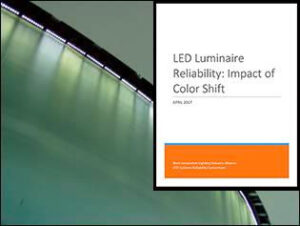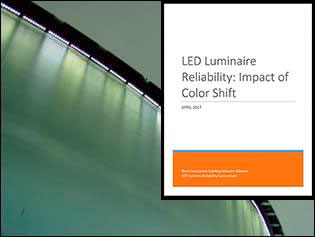
With LED lighting, end of life is determined by whichever occurs first: catastrophic failure, unacceptable lumen depreciation, or unacceptable color shift. The latter two parameters are not absolute, but depend on the application. While LED lighting is less prone to shifts in color than are other lighting technologies, the long lifetimes of LED lighting products—which can last well beyond 50,000 hours—can make such changes more pronounced. In addition, the end of life for LED luminaires can be less evident than for conventional lighting, because changes in light output and/or color may be gradual.
To address the challenge of developing accurate lifetime claims, DOE, together with the Next Generation Lighting Industry Alliance, formed an industry working group, the LED Systems Reliability Consortium (LSRC). The LSRC has published three editions of LED Luminaire Lifetime: Recommendations for Testing and Reporting, focusing primarily on lumen depreciation and catastrophic failure. Those reports concluded that numerous subsystems and components in a luminaire, in addition to the LEDs, introduce potential failure modes. A new LSRC report, LED Luminaire Reliability: Impact of Color Shift, focuses on chromaticity. The purpose of the new report is not to define limits for specific applications, but rather to enable a better understanding of how and why color shifts, and how that impacts reliability.
Chromaticity shift in LED packages is very complex, with different mechanisms at play, depending on package materials and construction. But the chromaticity shift can progress in a fairly predictable pattern, depending on junction temperature. The ambient temperature, optical flux density, presence of moisture for phosphor particles and neighboring binder material also affect the rate of chromaticity shift. Within an LED package, the phosphor temperatures can be 30 deg C to 50 deg C above the junction temperature of the LED chip. At high temperatures and long operating times, the materials in the package can discolor, crack or delaminate—leading to chromaticity shift and lumen depreciation. Red phosphors also can experience a decrease in peak wavelength in the presence of moisture and heat, which can impact the chromaticity of warm-white LED packages.
In addition to the chromaticity shift behavior from the LED packages, optical materials in the lamps and luminaires tend to yellow or discolor due to oxidation effects, leading to chromaticity shifts in the yellow direction. While LED chromaticity shift does occur and can impact the performance of LED lighting products, the new understanding summarized in the LSRC report has allowed the industry to manage the negative impact of such a shift. Although LED-based lighting can exhibit significantly improved color stability compared to conventional lighting products, its long lifetime requires an understanding of how color might shift over extended period. Further research is needed to develop improved predictive models that will enable manufacturers and consumers to understand the tradeoffs and make informed decisions regarding LED lighting performance requirements and product capabilities.
Further work is needed in understanding, projecting, and communicating the chromaticity shift behavior in LED packages. An IES TM-31 working group is developing a standard for projecting long-term chromaticity maintenance of LED packages, possibly from LM-80 data. Ideally, a chromaticity shift model can be developed for different package types to determine the time to a certain chromaticity shift magnitude that can be inserted in a system reliability model to predict the behavior of an LED luminaire or lamp.
Beyond the efforts of the TM-31 working group, DOE has funded R&D on this topic. RTI International has been investigating it by analyzing color shift data from LED packages (LM-80 reports), LED lamps (CALiPER Report 20.5: Chromaticity Shift Modes of LED PAR38 Lamps Operated in Steady-State Conditions), and luminaires from accelerated stress testing. Models are currently being developed and need to be tested. Further research is required to understand the different color shift mechanisms in the different luminaire subsystems and to develop accelerated testing methods and predictive models to further improve the manufacturer’s ability to bring color-stable lighting products to the customer.
The LSRC’s ultimate goal is to develop an approach to lifetime projection that takes into account catastrophic failure, lumen depreciation, and color shift all together. We’re continuing to work on that, so stay tuned.

